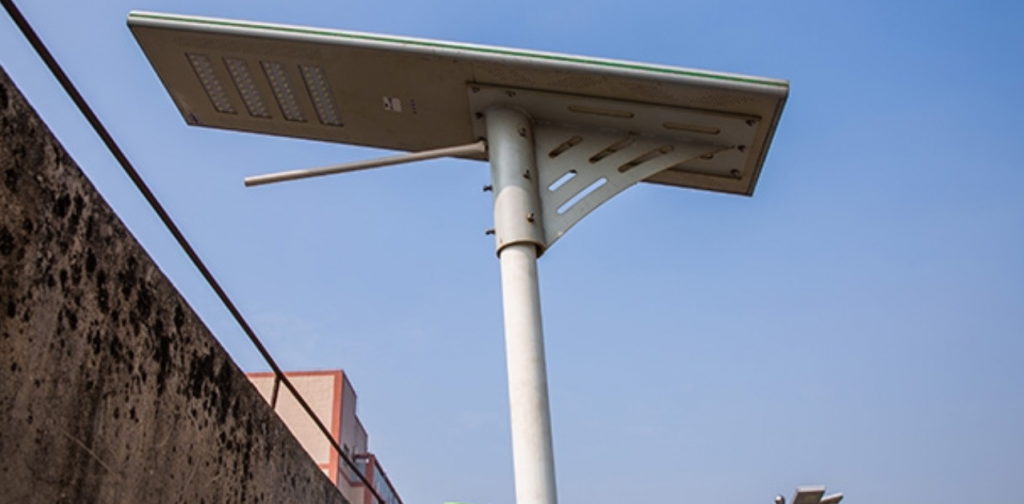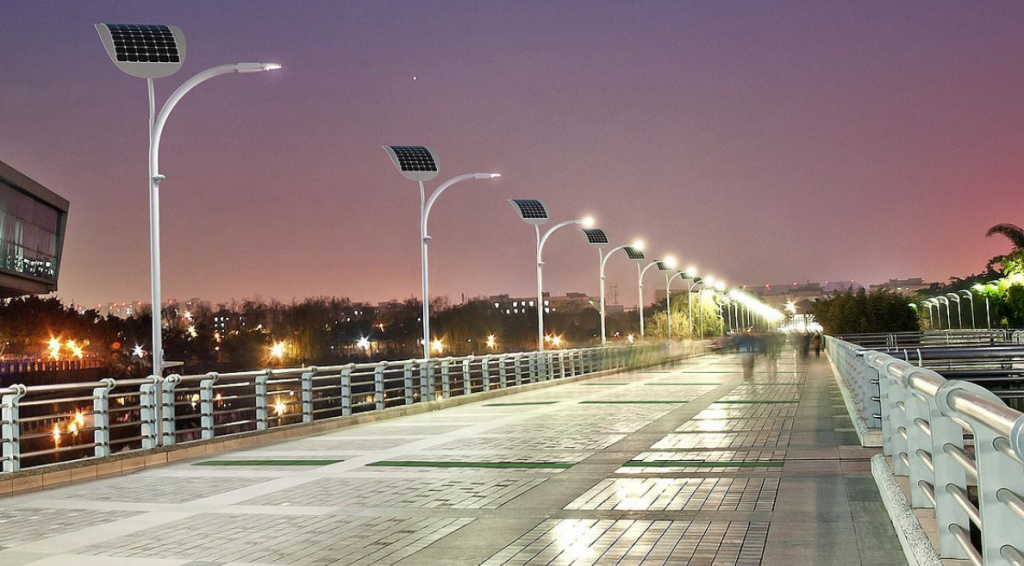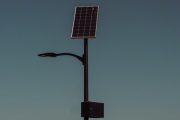Brief Introduction
With the continuous improvement of solar cell conversion efficiency and production technology, the application of solar photovoltaic power generation has become more and more extensive. In the field of lighting, solar street lights, as the main application mode of photovoltaic power generation systems, are more and more recognized and accepted. Through the analysis of the solar street light data of many companies, we found that many people consider the bias in the design of the solar street light system, such as the consideration of the peak time, the choice of battery capacity, and the understanding of continuous rainy days.
Based on the practical experience in the work, this paper further discusses and analyzes the design points of solar street lights.
1. Basic Structure and Working Principle of Solar Street Light
(1) Basic structure of solar street light
Solar street lights are mainly composed of solar cell components, components, brackets, light sources, controllers, batteries, light poles and other parts.
(2) The working principle of solar street lights
Solar street lights use the photovoltaic effect principle of solar cells. During the day, solar cells absorb solar photon energy to generate electricity, which is stored in the battery through the controller. When night falls or the illumination around the light is low, the battery supplies power to the light source through the controller until the set time is cut off.
2. Data Required for Street Light Design
(1) Find the longitude and latitude of the place of use by knowing the place where the solar street light is used. Determine the inclination angle and azimuth angle of solar cell modules and calculate the standard peak sunshine time of solar energy in this area through the “Database of Solar Radiation on Different Inclined Surfaces”.
(2) The power (W) of the light source selected for the street light. The size of the light source power directly affects the parameter stability of the entire system.
(3) The working hours (H) of solar street lights every night. This is the core parameter that determines the size of the components in the solar street light system. By determining the working time, the daily power consumption of the load and the corresponding charging current of the solar cell assembly can be preliminarily calculated.
(4) The number of consecutive rainy days (d) that the solar street light needs to maintain. This parameter determines the size of the battery capacity and the solar cell module power required to restore the battery capacity after a cloudy and rainy day.
(5) Determine the interval D between two consecutive cloudy and rainy days. This is to determine the battery pack power required for the system to fully charge the battery after a continuous rainy day.
3. Design Ideas and Key Points of Solar Street Light System
The basic principles of solar photovoltaic power generation systems are the same, so the design ideas of solar street lights can also be based on general solar power generation systems. First determine the power of the light source, the daily working hours, and ensure several rainy days, and then calculate the capacity of the battery and the power of the solar cell module. However, solar street lights have their particularities, and it is necessary to ensure the stability and reliability of the system, so special attention should be paid to the design.
(1) Solar cell module
The voltage of a solar cell module decreases as the temperature increases. Due to the influence of high temperature, the voltage loss of battery components is about 2V, and the diode voltage drop on the charging process controller is 0.7V, so components with an operating voltage of 18V are selected. Due to the particularity of solar street lights, solar panels are generally installed on light poles. For street light poles, it is generally more than 5 meters, the center of gravity is high, and most solar panels are suspended. In order to enhance the wind resistance of the whole set of equipment, multiple solar panels are generally selected to form the required component power.
(2) Battery (group)
When choosing a battery, it is necessary to consider the impact of the discharge rate on the battery capacity, the impact of temperature on the battery capacity, and the impact of the depth of discharge on the battery capacity. Therefore, a deep-cycle solar battery must be selected. When the battery is connected in parallel, the unbalanced effect between the individual cells needs to be considered. Normally, the number of parallel groups should not exceed 4 groups.
(3) Controller
The controller is a key component that acts as a manager in the entire street light system, and its biggest function is to comprehensively manage the battery. A good controller should set various key parameter points according to the characteristics of the battery, such as the overcharge point, overdischarge point, recovery connection point and SOC discharge control of the battery.
When choosing a street light controller, special attention should be paid to the parameters of the controller recovery connection point. Since the battery has voltage self-recovery characteristics, when the battery is in an over-discharge state, the controller cuts off the load, and then the battery voltage recovers. If the parameter points of the controller are not properly set, the lights may flicker and the life of the battery and light source will be shortened.
(4) Selection of light source
The selection of the light source is the most critical step for solar street lights. At present, there are few light sources dedicated to solar street lights. In order to reduce the loss of limited energy, the light source should be DC light source as far as possible.
At present, the common light sources are DC energy-saving lights, high-frequency induction lights, low-pressure sodium lights and LED light sources. As a semiconductor light source, LED has a strong development momentum and is the most ideal light source for solar street lights.
LED street light source is a multi-functional, environmentally friendly and energy-saving street light source, suitable for lighting in various occasions. The LED street light driver is a product specially developed for the LED street light system, which is used to provide a stable power supply for the LED lights. Using advanced electronic power technology, two output modes of high-efficiency enhancement and ultra-energy-saving pulse width modulation (PWM) are designed. 
With time control, it can be used when needed (when there are many black people and many cars in the first half of the night). Efficiency-enhancing mode lights up LED fixtures to provide good lighting. In other time periods (when there are few people and vehicles in the second half of the night), the output is in the ultra-energy-saving mode, which saves the power consumption of the battery. In addition, the lighting brightness of most solar street light projects needs to meet the urban road lighting standards.
4. Conclusion
The design of solar street lights needs to be scientific and reasonable. In addition to the above points, it is also necessary to consider the overall structure of the street light, especially the calculation of the wind resistance of the street light and the overall aesthetics of the street light in combination with the urban road design.
In short, there are many factors that affect the performance of solar street lights. Some people tend to regard the sunshine time as the solar peak hours when designing solar street light systems, but this is not correct. The result of this design will lead to instability of the entire system. Only by mastering the detailed meteorological resources and operating conditions of the place of use, combined with practical experience and optimizing the system design, can the solar street light work normally.




